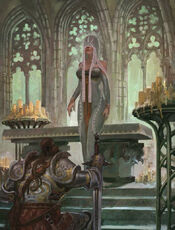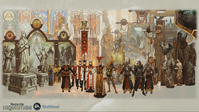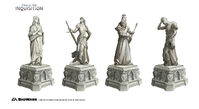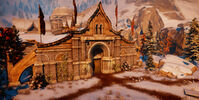The Chantry is the dominant religious organization in Thedas. It is based on the Chant of Light, a series of teachings written by Andraste, the prophet of the Maker, and was founded by Kordillus Drakon, the first emperor of Orlais. The Chantry's followers are known as Andrastians. "Chantric" is also an acceptable adjective to refer to something or someone that is of the Chantry religion.
The Chantry's goal is to spread the Chant of Light to all four corners of the world and to all races. The view of the Chantry on non-humans is that they need saving—they have turned even further from the Maker's grace than humanity has. There are no known Andrastian Qunari. The elves worshipped, and in some cases still worship, the Elven pantheon, and dwarves venerate the Stone. Once all peoples have accepted the Chant and practice its teachings, the Maker will return and restore the world to its former glory. As such, Andrastian religion in Thedas can be described as deistic in that the Maker abandoned the world, and he will not heed prayer or perform any other function until his favor is regained.
The Chantry calendar is used everywhere in Thedas, save for the Imperium, and is the source of the names of the Ages.
History
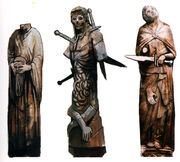
A cult known as the Cult of the Maker grew out of the legend of Andraste's martrydom.[2] The cult had no central leadership[3] and its followers were oppressed.[4] The clerics had to hide their lore from Tevinter magisters by way of ciphers and encoded scrolls.[5] In -130 Ancient, cult practitioners organized Andraste's teachings into hymns, creating the Chant of Light and the cult popularity spread.[6]
The cult remained fragmented until it was formalized into the Chantry by Kordillus Drakon, the first Emperor of the newly formed Orlesian Empire, in -3 Ancient. Drakon established Andrastianism as the national religion and was himself a fervent believer in the Maker. Three years later the first Divine, Justinia I, was declared. Drakon's military successes during the Second Blight significantly expanded the borders of Orlais, and soon after, the conquered lands converted to the faith. While these lands would later liberate themselves from Orlesian rule following Drakon's death, the Chantry's practice remained.
The Antivan Crows started as an arm of the Chantry. In the hills north of Treviso, an order of monks used the herbs grown in the gardens of their abbey to oppose the rule of a despotic duke in the only manner the monks could.[7]
During the Towers Age there was debate in the Chantry over whether Andraste was truly divine. It was largely the Imperial Chantry's belief that she was not divine that led to the schism in the Chantry and the eventual founding of the Imperial Chantry as a separate religion in 3:87 Towers.[8][9]
With so much influence over the people, the Chantry can exert considerable political pressure on the ruling classes in many areas of concern. In extraordinary times, and in deference to Andraste, the Divine may also be moved to declare an Exalted March. These religious crusades have mobilized armies of thousands to destroy the heretical enemies of the Maker. The first March after Andraste's death was against the elves of the Dales.[10] The next four were against Tevinter, and the most recent was against the Qunari. Tevinter also took part in the latest march.[11]
At a later stage of the Mage-Templar War, Divine Justinia V managed to organize peace talks between representatives of both mages and templars at the Temple of Sacred Ashes. However, Corypheus infiltrated the conclave to use Justinia as a ritualistic sacrifice. The ritual was interrupted and the following massive explosion killed the Divine and most of the Grand Clerics worthy to succeed her, creating the Breach in the sky and ushering in a rash of Veil Tears throughout the area. The Chantry was, until the Breach, "the thing keeping the lid on the pot of Thedas."[12] After the Breach and with no Divine to guide them, Chantry leadership succumbed to chaos with no clear successor for the Divine.[13] What's more, Chancellor Roderick used his influence to convince the remaining clerics to publicly denounce the reformed Inquisition, calling them heretics for harbouring the sole survivor of the conclave attack, the Inquisitor, who had been labeled the Herald of Andraste.
The Inquisitor arrives in Val Royeaux on the advice of Mother Giselle to address the clerics and give some of them reason to doubt their denouncement, as the opposition's strength was in their unity. The Chantry were further humiliated when Lord Seeker Lucius Corin refused to bring the templars back into their fold.
As the Inquisition acclaimed great renown, the Chantry started reaching out to the Inquisition for the Hands of the late Divine, Cassandra Pentaghast and Leliana, to stand as potential candidates for the title of Divine.
Chantry hierarchy
- See also: Codex entry: Chantry Hierarchy
The actual priesthood of the Chantry is made up entirely of women, on the basis that Andraste was a woman. At the head of the Chantry is the Divine, who leads from her seat in the Grand Cathedral of Val Royeaux. Below her are the Grand Clerics who are the Chantry's highest authority in a country or a region. After a Divine dies, Grand Clerics are required to travel to Val Royeaux for the Grand Consensus, a meeting where Chantry leadership unanimously elect the new leader of the Chantry. Beneath the Grand Clerics are the mothers, who are responsible for administering to the spiritual well-being of their flock. If a mother is in charge of a local Chantry, she is called a Revered Mother. Beneath mothers are the brothers and sisters, consisting of three main groups: affirmed, initiates, and clerics. Brother is the only rank that men are allowed to have. The initiates take vows and receive an academic education. Those who seek to become templars receive a martial education in addition. Clerics are the scholars of the Chantry and the most senior of them receive the title of "elder," which is, however, beneath that of mother.
Practices
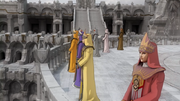
Chantry clergy greet pilgrims during the Ten Year Gathering.
The funeral rites of the Chantry involve cremation. As Andraste's body was burned, and her spirit ascended to stand by the Throne of the Maker, so too will the spirits of her followers. The practice of cremation may also be to ward off the possibility of the corpse becoming the subject of demonic possession.
The pyres of peasants are often small and ringed with stones. Such burnings occur within the settlement, despite the fire risk, rather than at a distance. Criminals may be burned in a mass pyre.[14]
The Chantry hosts a Ten Year Gathering, in which pilgrims journey to the Grand Cathedral in Val Royeaux to pray for peace.[15]
The faithful who give their lives to the Exalted Marches earn a special place at the side of the Maker as the "Exalted".[16] A still greater honor for service, the defenders of the faith are sometimes given the title of "Anointed".[17][18][19][20][21] The Anointed are seen as the hands of the Maker and the title is exceptionally rare.[16]
The role of men in the Chantry
Though men are able to become true priests in the Imperial Chantry of the Tevinter Imperium, in the rest of the Thedas they are judged by the betrayal of Maferath and found too passionate to lead in matters of spirit. Nevertheless, male members of the Chantry can and do play a vital role in its workings.
Though men are generally assumed to be merely templars, chanters or scholars, they also comprise an "invisible army" that keeps the Chanty fed and in good repair, and also sees to the physical well-being of Andrastian faithful. Furthermore, the male role of High Chancellor is one that works directly alongside the Divine and is in many ways her administrator and public gatekeeper. In this way, the Chantry's male acolytes allow their female counterparts to guide the souls of Thedas while seeing to it that small but vital services are rendered to their material lives.[22]
Symbols
The sun represents the fundamental goal of the Chantry: if all lands under the sun raise their voices in the Chant, then the Maker's eye will turn back to his Children.[23]
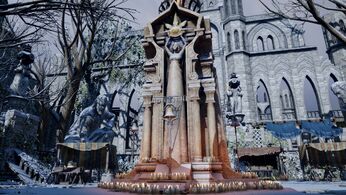
A shrine in Suledin Keep depicting a sun and a stylized Andraste
Chantries in Thedas
Members of the Chantry often worship in buildings called chantries. These chantries are present in almost every village, town and city and some will also maintain a Chanter's Board. At most chantries a religious character can receive a blessing or agree with the faithful. A non-religious character can disagree with the faithful, refuse a blessing or refuse to donate coin.
Chantries deliver practical services to the community, caring for the sick and collecting alms for the poor. The Chantry provides hospitality to travelers and a public network of communications. Should an illiterate commoner need to send word to another town, the Chantry's educated priests write and send the letter for him.
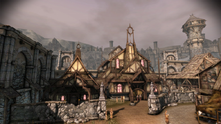
The Denerim cathedral
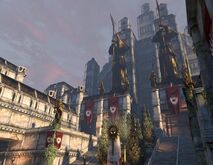
The Kirkwall chantry
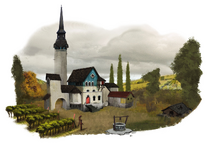
A countryside chapel in Orlais
- Lothering chantry, Lothering (destroyed by the Darkspawn in Dragon 9:30)
- Denerim Cathedral, Denerim Market District
- Chantry of our Lady Redeemer, City of Amaranthine (this chantry can be destroyed, depending on player choices)
- Village Chantry, Redcliffe Village (this chantry can become abandoned, depending on player choices)
- An additional chantry is built subsequently in the new eastern district of the village around 9:40 Dragon.
- Haven Chantry, Village of Haven (this chantry is not part of the Andastrian Chantry as it is operated by the Disciples of Andraste. In 9:35 on Divine Justinia V's Orders it was restored as part of the Andastrian Chantry, Destroyed in 9:41 by The Elder One's Army)
- Orzammar chantry, Orzammar Commons (this chantry can be prevented from ever forming, depending on player choices)
- Alternatively, a Circle of Magi outside of the Chantry's control can be established depending on player choices.
- Abandoned Chantry, Forlorn Cove (this abandoned site can be the scene of bloodshed, depending on player choices)
- Kirkwall Chantry, Hightown-Kirkwall (destroyed in 9:37 Dragon)
- Grand Cathedral, Val Royeaux
- Chantry of the Stilled Tongue, a "maniac splinter cult" of the Andrastian Chantry, with a preemptive perspective on sin[24]
- Andraste's Ear, a small Chantry in "the Dregs," a working-class Denerim neighborhood[25]
- University of Orlais, this chantry's courtyard is decorated with a mosaic of Andraste. [26]
- Chateau Serault Chantry, this chantry was sealed after the former Marquis of Serault was revealed to be an Apostate Mage and became an Abomination [27]
- Abbey of the Bans, an unorthodox Chantry in Serault. [28]
- Valence Cloister - Formerly the Chantry of Revered Mother Dorothea, later Divine Justinia V
Chapels
Chapels are located in larger self-contained buildings for the convenience of their inhabitants. These mostly include castles, forts and the Circle of Magi. At all chapels a religious character may receive a blessing or participate in a prayer to the Maker. A non-religious character can disagree with the faithful or refuse a blessing.
- Fort Drakon, Denerim (blessing is only available if using the disguise method of escape during Captured!)
- Castle Cousland, Highever (blessing and prayer is only available to the Human Noble Origin)
- Redcliffe Castle, Redcliffe (blessing only available after the castle's problems are solved)
- Kinloch Hold, Lake Calenhad (prayer only available in Magi Origin)
- Weisshaupt Fortress, Anderfels [29]
- Skyhold
Trivia
- A chantry can serve as a neutral ground for two parties at war to meet, where violence is forbidden.[30]
Related codex entries
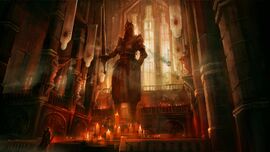
A Chantry altar
![]() Codex entry: The Founding of the Chantry
Codex entry: The Founding of the Chantry
![]() Codex entry: The History of the Chantry: Chapter 1
Codex entry: The History of the Chantry: Chapter 1
![]() Codex entry: The History of the Chantry: Chapter 2
Codex entry: The History of the Chantry: Chapter 2
![]() Codex entry: The History of the Chantry: Chapter 3
Codex entry: The History of the Chantry: Chapter 3
![]() Codex entry: The History of the Chantry: Chapter 4
Codex entry: The History of the Chantry: Chapter 4
![]() Codex entry: The Imperial Chantry
Codex entry: The Imperial Chantry
![]() Codex entry: Andraste: Bride of the Maker
Codex entry: Andraste: Bride of the Maker
![]() Codex entry: Chantry Hierarchy
Codex entry: Chantry Hierarchy
Gallery
References
| ||||||||||||||||||||||||

